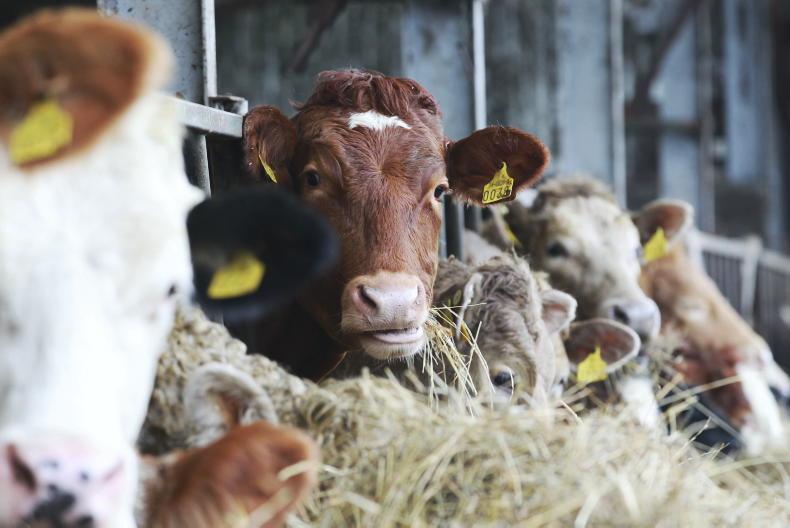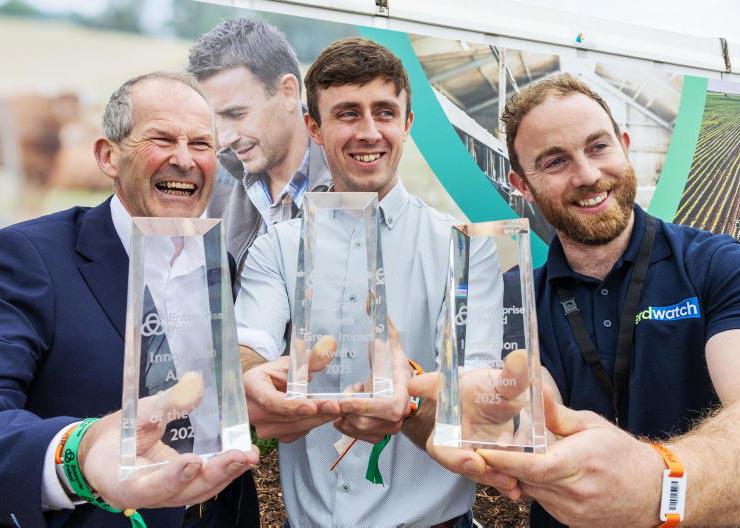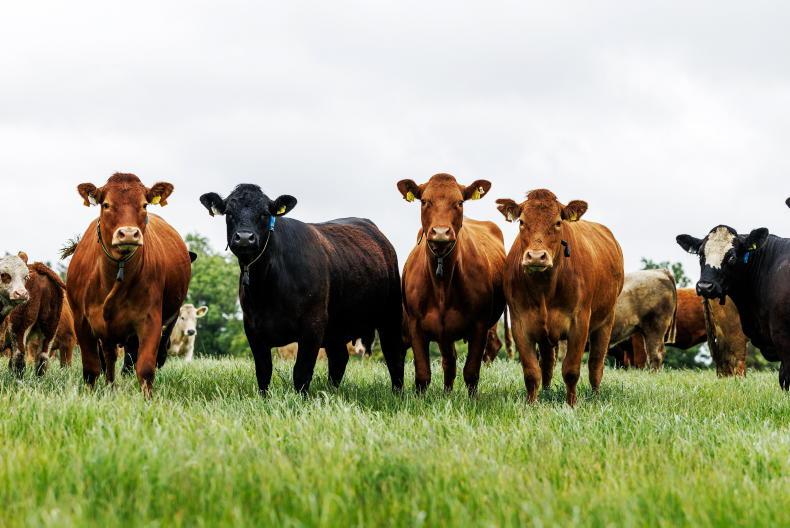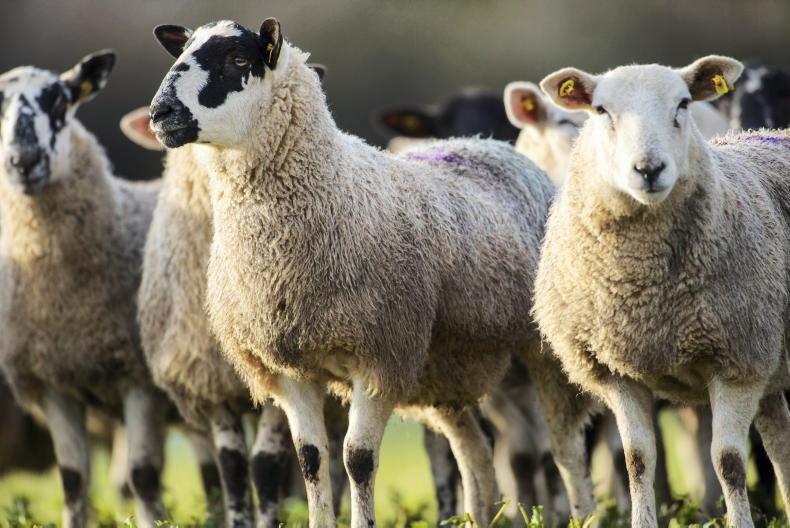Tullamore Farm has recorded an improvement in flock reproductive performance for the second year running, with the average litter size per ewe joined increasing by 0.16 lambs to 1.91 lambs.
As detailed in Table 1, flock reproductive performance is still running below the high levels of performance recorded in the first three years of the project, but thankfully well ahead of the sharp fall-off in performance in the 2020/2021 breeding season.
To briefly recap for those who are not familiar, the farm experienced an unexplained spike in barren rates in mature ewes, while the in-lamb rate was also much lower.
Early embryonic death was thought to be the cause, but extensive investigation failed to definitively identify the reason. Management has not changed since and reproductive performance improved last year, but was still well below the target set for the flock.
Issues were mainly confined to mature ewes, but were also experienced (albeit at a much reduced level) in hogget ewes.
2022 / 2023 performance
Barren rates were increased across all age categories, but the lower in-lamb rate was most evident in older ewes. A significant percentage of these ewes have since been culled, and performance has improved significantly in ewes remaining.
The breakdown in litter size of aged ewes born between 2013 and 2018 is detailed in Figure 1. These figures have all been captured through the Sheep Ireland app, which is free for commercial farmers to use and is an excellent resource to analyse performance.
There is just one 2013 and one 2014-born ewe remaining in the flock, with a handful of 2015 born ewes, 10 2016-born ewes, 11 2017-born and about 25 2018-born.
This batch of ewes achieved an average litter size of 2.04 lambs per ewe joined to the ram. These ewes are Mule ewes, and this is closer to the performance expected from this breed type.
Younger ewes
A strong focus on the liveweight of ewe lambs at time of joining with rams is viewed as helping performance with this mating group.
The in-lamb rate in two-tooth hogget ewes has reduced year-on-year, but it was suspected that this could have been a factor this season due to challenging weather in 2022.
These hoggets achieved positive reproductive performance as ewe lambs, with an in-lamb rate of 1.55 lambs per ewe mated.
Despite preferential treatment in early lactation, these ewes had to contend with tight fodder supplies and suboptimal grass quality pre and post weaning, which has had a knock on effect on reproductive performance.
Interestingly, Texel-cross ewes achieved a higher scanning rate of 1.85 lambs per ewe joined.
These sheep were under much less pressure than their Mule-bred comrades as they joined the ram at an average weight of 56kg, compared to about 45kg for the Mules.
There was much less nutritional pressure on these animals. The knock-on consequences of yearling hoggets experiencing challenging conditions when rearing lambs and recording reduced reproductive performance in the subsequent year has also been seen in the Teagasc BETTER farm sheep programme.
This reinforces the importance of prioritising this group as a single management unit.
Ewe lamb performance
Scanning results in the batch of 48 ewe lambs which were joined to the ram have been positive. These ewe lambs were joined after the first breeding cycle in mature ewes and hoggets, and the breeding season was concluded at just less than four weeks.
The reasoning for a short breeding season was to avoid a drawn out lambing period, with attention turning from lambing to breeding in the suckler herd very quickly.
The barren rate of 10.4% is down on last year and farm manager, Shaun Diver comments that a greater focus on having Mule ewe lambs at a heavier weight has helped this figure.
The litter size and in-lamb rate is down on last year’s levels but again it is thought that the challenging year with drought has likely also had an effect on performance with this batch.
Contrasting views
Given the likely higher costs of rearing lambs artificially in 2023, many would argue that the scanning rate in ewe hoggets is possibly more advantageous than a scan with a high percentage of triplet litters, with 77.4% of ewes carrying twin litters (see Table 2).
The scan in mature ewes has 23.3% triplet litters and a similar figure of 24.4% of ewes carrying a single lamb. The latter figure is about 10% higher than desired, with the aim in a prolific flock to have 60% plus of ewes carrying twin lambs.
However Shaun hopes that he can capitalise on cross fostering to reduce the number of lambs that need to be reared artificially.
Management
Mature ewes have been housed in the last week, a few weeks earlier than in 2022. This was as a result of poor grass utilisation rather than poor grass supplies (and access to catch crops), with grass covers recovering strongly in October and growth holding above normal well in to November.
Shaun says that ewes are in excellent condition and that this should bode well in limiting concentrate usage in late pregnancy.
Silage quality is good, testing in the mid-70s for DMD, and Shaun is hoping to delay feeding concentrates to twin-bearing ewes until five to six weeks pre-lambing.
Triplet bearing ewes are likely to receive feeding at a lower level eight to nine weeks out from lambing with the aim to safeguard body condition for using in early lactation.
The farm gained access to a small area of catch crops on the tillage farm from which it purchases straw, with ewe hoggets and ewe lambs grazing there for the month of December.
Ewe lambs remain on this crop and the aim is to extend the grazing period until the end of January and possibly in to February, depending on weather and crop utilisation.
Lambing preparations
Raddle markings indicate a tight lambing spread with in the region of 90% of ewes and hoggets mated in the first two weeks of the breeding season and a low number of repeat mating’s recorded.
With flock numbers increasing significantly there will be a renewed focus on lambing preparations and in particular having sufficient lambing pens available. Space for the first two weeks of lambing has been at a premium in recent years.
The construction of a new suckler shed will free up space to house ewes in a three-bay shed that was previously used to house cows and calves. This shed may be initially used to house triplet bearing ewes providing scope to set up additional lambing pens within this area.
This practice of setting up penning within the lambing area has worked well for Shaun in recent years during the peak lambing period to allow ewes and lambs to be transferred quickly if required to temporary penning before being moved to permanent lambing pens.
Flock reproductive performance has improved with the scanning rate in mature ewes increasing by 0.16 lambs to 1.91 lambs per ewe joined.The higher performance has been driven by a high in-lamb rate and lower barren rate.Performance in two-tooth hoggets was lower than in previous years, likely as a result of the challenging year. The scanning rate in ewe lambs is satisfactory following a four week breeding period.
Tullamore Farm has recorded an improvement in flock reproductive performance for the second year running, with the average litter size per ewe joined increasing by 0.16 lambs to 1.91 lambs.
As detailed in Table 1, flock reproductive performance is still running below the high levels of performance recorded in the first three years of the project, but thankfully well ahead of the sharp fall-off in performance in the 2020/2021 breeding season.
To briefly recap for those who are not familiar, the farm experienced an unexplained spike in barren rates in mature ewes, while the in-lamb rate was also much lower.
Early embryonic death was thought to be the cause, but extensive investigation failed to definitively identify the reason. Management has not changed since and reproductive performance improved last year, but was still well below the target set for the flock.
Issues were mainly confined to mature ewes, but were also experienced (albeit at a much reduced level) in hogget ewes.
2022 / 2023 performance
Barren rates were increased across all age categories, but the lower in-lamb rate was most evident in older ewes. A significant percentage of these ewes have since been culled, and performance has improved significantly in ewes remaining.
The breakdown in litter size of aged ewes born between 2013 and 2018 is detailed in Figure 1. These figures have all been captured through the Sheep Ireland app, which is free for commercial farmers to use and is an excellent resource to analyse performance.
There is just one 2013 and one 2014-born ewe remaining in the flock, with a handful of 2015 born ewes, 10 2016-born ewes, 11 2017-born and about 25 2018-born.
This batch of ewes achieved an average litter size of 2.04 lambs per ewe joined to the ram. These ewes are Mule ewes, and this is closer to the performance expected from this breed type.
Younger ewes
A strong focus on the liveweight of ewe lambs at time of joining with rams is viewed as helping performance with this mating group.
The in-lamb rate in two-tooth hogget ewes has reduced year-on-year, but it was suspected that this could have been a factor this season due to challenging weather in 2022.
These hoggets achieved positive reproductive performance as ewe lambs, with an in-lamb rate of 1.55 lambs per ewe mated.
Despite preferential treatment in early lactation, these ewes had to contend with tight fodder supplies and suboptimal grass quality pre and post weaning, which has had a knock on effect on reproductive performance.
Interestingly, Texel-cross ewes achieved a higher scanning rate of 1.85 lambs per ewe joined.
These sheep were under much less pressure than their Mule-bred comrades as they joined the ram at an average weight of 56kg, compared to about 45kg for the Mules.
There was much less nutritional pressure on these animals. The knock-on consequences of yearling hoggets experiencing challenging conditions when rearing lambs and recording reduced reproductive performance in the subsequent year has also been seen in the Teagasc BETTER farm sheep programme.
This reinforces the importance of prioritising this group as a single management unit.
Ewe lamb performance
Scanning results in the batch of 48 ewe lambs which were joined to the ram have been positive. These ewe lambs were joined after the first breeding cycle in mature ewes and hoggets, and the breeding season was concluded at just less than four weeks.
The reasoning for a short breeding season was to avoid a drawn out lambing period, with attention turning from lambing to breeding in the suckler herd very quickly.
The barren rate of 10.4% is down on last year and farm manager, Shaun Diver comments that a greater focus on having Mule ewe lambs at a heavier weight has helped this figure.
The litter size and in-lamb rate is down on last year’s levels but again it is thought that the challenging year with drought has likely also had an effect on performance with this batch.
Contrasting views
Given the likely higher costs of rearing lambs artificially in 2023, many would argue that the scanning rate in ewe hoggets is possibly more advantageous than a scan with a high percentage of triplet litters, with 77.4% of ewes carrying twin litters (see Table 2).
The scan in mature ewes has 23.3% triplet litters and a similar figure of 24.4% of ewes carrying a single lamb. The latter figure is about 10% higher than desired, with the aim in a prolific flock to have 60% plus of ewes carrying twin lambs.
However Shaun hopes that he can capitalise on cross fostering to reduce the number of lambs that need to be reared artificially.
Management
Mature ewes have been housed in the last week, a few weeks earlier than in 2022. This was as a result of poor grass utilisation rather than poor grass supplies (and access to catch crops), with grass covers recovering strongly in October and growth holding above normal well in to November.
Shaun says that ewes are in excellent condition and that this should bode well in limiting concentrate usage in late pregnancy.
Silage quality is good, testing in the mid-70s for DMD, and Shaun is hoping to delay feeding concentrates to twin-bearing ewes until five to six weeks pre-lambing.
Triplet bearing ewes are likely to receive feeding at a lower level eight to nine weeks out from lambing with the aim to safeguard body condition for using in early lactation.
The farm gained access to a small area of catch crops on the tillage farm from which it purchases straw, with ewe hoggets and ewe lambs grazing there for the month of December.
Ewe lambs remain on this crop and the aim is to extend the grazing period until the end of January and possibly in to February, depending on weather and crop utilisation.
Lambing preparations
Raddle markings indicate a tight lambing spread with in the region of 90% of ewes and hoggets mated in the first two weeks of the breeding season and a low number of repeat mating’s recorded.
With flock numbers increasing significantly there will be a renewed focus on lambing preparations and in particular having sufficient lambing pens available. Space for the first two weeks of lambing has been at a premium in recent years.
The construction of a new suckler shed will free up space to house ewes in a three-bay shed that was previously used to house cows and calves. This shed may be initially used to house triplet bearing ewes providing scope to set up additional lambing pens within this area.
This practice of setting up penning within the lambing area has worked well for Shaun in recent years during the peak lambing period to allow ewes and lambs to be transferred quickly if required to temporary penning before being moved to permanent lambing pens.
Flock reproductive performance has improved with the scanning rate in mature ewes increasing by 0.16 lambs to 1.91 lambs per ewe joined.The higher performance has been driven by a high in-lamb rate and lower barren rate.Performance in two-tooth hoggets was lower than in previous years, likely as a result of the challenging year. The scanning rate in ewe lambs is satisfactory following a four week breeding period. 









SHARING OPTIONS